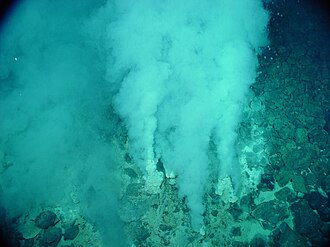
Back Vroegste bekende lewensvorme Afrikaans أقدم أشكال الحياة المعروفة Arabic Πρωιμότερες γνωστές μορφές ζωής Greek Primeras formas de vida conocidas Spanish اولین شواهد حیات Persian Fossiles les plus anciens French Կյանքի ամենահին հայտնի ձևեր Armenian Bentuk kehidupan paling awal yang diketahui ID Байқалған ең ежелгі тіршілік формалары Kazakh Bentuk kehidupan paling awal yang diketahui Malay

The earliest known life forms on Earth may be as old as 4.1 billion years (or Ga) according to biologically fractionated graphite inside a single zircon grain in the Jack Hills range of Australia.[2] The earliest evidence of life found in a stratigraphic unit, not just a single mineral grain, is the 3.7 Ga metasedimentary rocks containing graphite from the Isua Supracrustal Belt in Greenland.[3] The earliest direct known life on Earth are stromatolite fossils which have been found in 3.480-billion-year-old geyserite uncovered in the Dresser Formation of the Pilbara Craton of Western Australia.[4] Various microfossils of microorganisms have been found in 3.4 Ga rocks, including 3.465-billion-year-old Apex chert rocks from the same Australian craton region,[5] and in 3.42 Ga hydrothermal vent precipitates from Barberton, South Africa.[1] Much later in the geologic record, likely starting in 1.73 Ga, preserved molecular compounds of biologic origin are indicative of aerobic life.[6] Therefore, the earliest time for the origin of life on Earth is at most 3.5 billion years ago, possibly as early as 4.1 billion years ago — not long after the oceans formed 4.5 billion years ago and after the formation of the Earth 4.54 billion years ago.[7]
- ^ a b Cavalazzi, Barbara; et al. (14 July 2021). "Cellular remains in a ~3.42-billion-year-old subseafloor hydrothermal environment". Science Advances. 7 (9): eabf3963. Bibcode:2021SciA....7.3963C. doi:10.1126/sciadv.abf3963. PMC 8279515. PMID 34261651.
- ^ Bell, Elizabeth; Boehnke, Patrick; Harrison, T. Mark; Mao, Wendy L. (24 November 2015). "Potentially biogenic carbon preserved in a 4.1 billion-year-old zircon". Proceedings of the National Academy of Sciences of the United States of America. 112 (47): 14518–21. Bibcode:2015PNAS..11214518B. doi:10.1073/pnas.1517557112. PMC 4664351. PMID 26483481.
- ^ Ohtomo, Yoko; Kakegawa, Takeshi; Ishida, Akizumi; et al. (January 2014). "Evidence for biogenic graphite in early Archaean Isua metasedimentary rocks". Nature Geoscience. 7 (1): 25–28. Bibcode:2014NatGe...7...25O. doi:10.1038/ngeo2025. ISSN 1752-0894. S2CID 54767854.
- ^ Noffke, Nora; Christian, Daniel; Wacey, David; Hazen, Robert M. (16 November 2013). "Microbially Induced Sedimentary Structures Recording an Ancient Ecosystem in the ca. 3.48 Billion-Year-Old Dresser Formation, Pilbara, Western Australia". Astrobiology. 13 (12): 1103–24. Bibcode:2013AsBio..13.1103N. doi:10.1089/ast.2013.1030. ISSN 1531-1074. PMC 3870916. PMID 24205812.
- ^ Cite error: The named reference
PNAS-2017was invoked but never defined (see the help page). - ^ Hallmann, Christian; French, Katherine L.; Brocks, Jochen J. (2022-04-01). "Biomarkers in the Precambrian: Earth's Ancient Sedimentary Record of Life". Elements. 18 (2): 93–99. Bibcode:2022Eleme..18...93H. doi:10.2138/gselements.18.2.93. ISSN 1811-5217. S2CID 253517035.
- ^ "Age of the Earth". United States Geological Survey. 9 July 2007. Retrieved 2006-01-10.